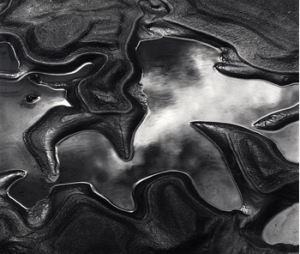
![]() In 1978, Brett Weston compiled a portfolio of photographs taken on trips to Alaska in 1973 and 1977. Typical of his later work, these images were generally nature abstractions, although he also included a few distant mountain landscapes and still lifes of totem poles, broken plastic, and a peeling cabin facade. Weston was drawn to finding compositions in the natural world. As he put it, “nature is such a magnificent arranger, and it is—all of it—always changing. You have to have an almost microscopic sense, a discerning, restless eye.”[footnote]Brett Weston Photographs from Five Decades (New York: Aperture, 1980), p.61.[/footnote]
In 1978, Brett Weston compiled a portfolio of photographs taken on trips to Alaska in 1973 and 1977. Typical of his later work, these images were generally nature abstractions, although he also included a few distant mountain landscapes and still lifes of totem poles, broken plastic, and a peeling cabin facade. Weston was drawn to finding compositions in the natural world. As he put it, “nature is such a magnificent arranger, and it is—all of it—always changing. You have to have an almost microscopic sense, a discerning, restless eye.”[footnote]Brett Weston Photographs from Five Decades (New York: Aperture, 1980), p.61.[/footnote]

Glacial Silt features clouds reflected in an irregularly shaped puddle. Unlike Weston’s Mountains and Clouds, New Mexico, taken around three decades earlier, Glacial Silt affords the viewer an intimate view of land and sky. The strong contrast between light and dark privileges the abstract design over recognizable imagery, while the reflected clouds set up a disconcerting spatial dynamic between the closely observed soil and the distant sky.
Glacial silt, also known as rock flour, is formed when glaciers scrape bedrock into fine particles of quartz and feldspar that is then carried away by tides or rivers or stirred up by wind to form deposits called loess. Soil scientists are studying the benefits of using rock flour to enrich soils that have been depleted by current agricultural and forestry practices.